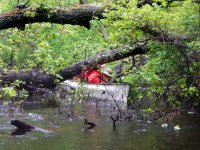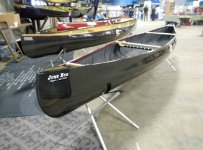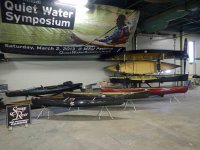On October 5-9, 2025, I paddled various parts of the Pine Barrens prior to the Pine Barrens Functional Freestyle Canoeing Workshop, being held right now from Oct. 10-12. Included among the paddlers on various days were seven USCA Freestyle instructors, including CTN members @Marc Ornstein, @tburris (Tim Burris), @85dragonfly (Bruce Kemp), @Damselfly (Manon Paquet) and @paulklonowski (Paul), along with other CTN members such as @NikonF5user (Russ), @RPATCH (Robert), @NoelCanoeDad (Dustin), @tketcham (Tom) and his wife Nancy, and @drsplatt (Ralph).
Bruce and Tim set up canopies at our main gathering site as Marc sits on the hitch of his trailer chatting with Manon.
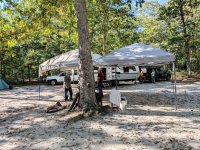
My corner of that site, which had direct lake access. Most of the trees are oaks, which continuously rained down acorns—banging and cracking on top our our vehicles and canoes, and booming when they hit the top of Marc's trailer. ALL NIGHT.
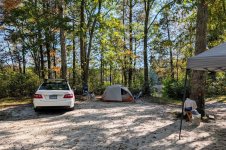
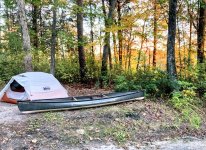
Marc in his self-designed Savage River Illusion, Curt in a Northstar Firebird and Bruce in a Curtis Dragonfly, prepare to negotiate the first of hundreds of 90° to 170° turns in the Barrens around bank corners and uncountable woody obstacles.
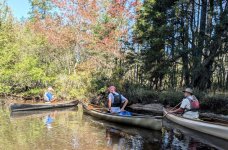
At the lunch spot on Monday, 12 open canoes are lined up on a rare sand beach shore. My gray Swift Keewaydin 15 (in the middle of the pack) and Robert Patch's blue Swift Dragonfly 15 (on the far end) were the longest canoes on the trip, and mine was the least maneuverable. Robert and I swapped canoes for an hour or so this day.
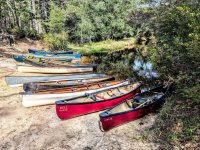
Back in his Swift D15, Robert and others in front of him enter a drought-stricken "lake".
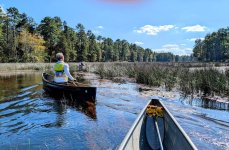
A harvest moon shines through the oak trees at night in camp . . .
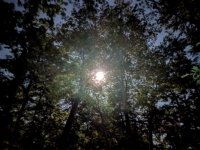
. . . and lightens up the sky and lake waters at the campsite.
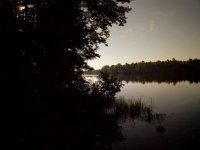
Every morning, most of us had breakfast at the Red Barn, which is located on a three-generation family farm and makes all their own pastries.
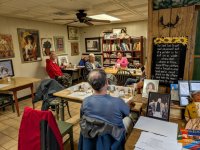

To run the many twisty, serpentine, convoluted, torturous and labyrinthine streams of the Pinelands, you are best prepared if you are in a maneuverable canoe and are skilled with strokes in all four quadrants of the canoe. For the acute and nonstop turns, and the frequent downed-tree, log and brush and sticker-bush obstructions, you will succeed best if you are skilled in currents with axles, posts, wedges, cross-axles, cross-posts, drawing and prying sideslips, draws, cross-draws, and cross-forward strokes. You will also need the simple back, far back and compound back strokes because you sometimes need to back up intentionally so as to make a move or get out of a checkmate. Also useful are impromptu paddle pushes off the bank or a log and hand-grabs of a branch.
Here, Marc does a cross-forward sweep as he ducks under multiple branches of a downed tree. There are scores of such obstructions on some of the rivers.
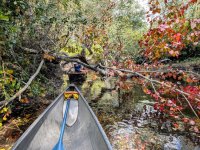
Sometimes, you must duck so low that no part of your body extends above the gunwales. In order to be able to do that from a central solo seat, the bow thwart must be at least 40 inches from the front edge of the seat, as Marc specifies for the Savage River solo canoes he has designed (June Bug, Illusion, Harmony).
The importance of this was empirically verified for me when I watched Marc disappear under his Illusion gunwales to get under a tree that spanned the river about 24 inches above the water. My boat went under the tree but my body-bend was blocked by my bow thwart, and hence my life-jacketed back caught on the trunk. There I was, wedged under the tree in current in a bent-over position. Checkmate!
Fortunately, the current was not strong in the low-water conditions, and Marc was able to push me backwards out from under the trunk. I then had to execute a turning compound back stroke get all the way out from under the log and angle my canoe for a forward stroke explosion to a narrow opening near the bank, which I should have taken in the first place. Good judgment, boat control and experience are all necessary when deciding whether, how and where to run complex obstructions.
For example, many of the logs and trees require angled "Z" maneuvers. Hence, unless you have a very short and turnable canoe, you might have to run the first part of a Z obstruction forward and the second part backward—or vice versa. Here, Robert is running his long canoe backward between the first and second trunks until he can duck under the second, which will enable him to run the next obstruction forward. Meanwhile the current is pushing him into the trunk and trying to tip him over, so he uses his hands as well as paddling to "make the move".
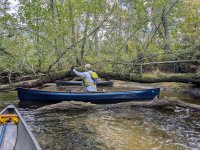
Buuuuut . . . there is another log lurking right after the first three. Sometimes you only have 10 seconds or so before you have to execute another complex maneuver around yet another obstruction or corner or both.
All is not so convoluted. Here, Manon paddles down a straight, canopied tunnel of coloring leaves . . .
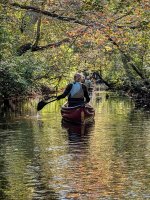
. . . only needing to employ a slight head tilt on her next stroke.
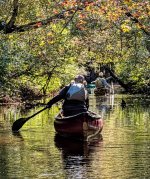
However, a few minutes later Manon approaches a serious problem. The old railroad trestle has vertical pilings just inches under the water that block and grab all hulls.
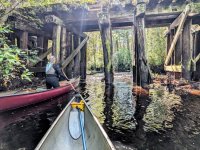
The right channel of the trestle is completely blocked by branches and brush. The center channel has too many sharp underwater pilings. So, we all must try our best on the least-blocked channel, which is the left. But Manon gets hung on the underwater grab-monsters (as we all do), and first tries to pull herself with her left hand while pushing one-handed with her paddle.
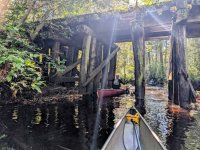
That doesn't work. So, she resorts to the method you must use many times on some of the rivers, which is to "skooch" the canoe by sliding/rocking it forward while up on your knees, hands on the gunwales.
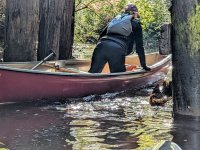
That eventually worked for her, as it did for me, and we watch the entire group of paddlers take about 15-20 minutes to "skooch the trestle". Curt is now in a Mohawk Solo 13, which has the reputation of being perhaps the best Royalex freestyle canoe.
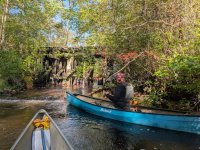
On yet another day, he paddled a Curtis Dragonfly. Note all the tannin in this river.
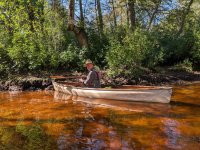
Some of the group sits on logs at a lunch spot.
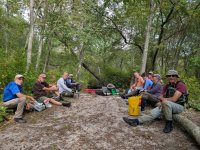
While the canoes also get a well-needed rest.
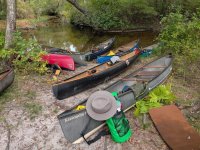
Bruce Kemp and Manon's husband, Jim Satrape, prefer to stand. Bruce organizes the Western Pennsylvania Solo Canoe Rendezvous (WPASCR).
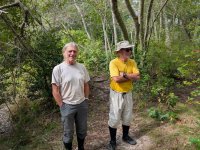
Manon and Jim at another day's lunch spot. They organize the Midwest Canoe Symposium.
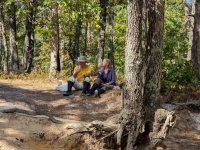
After lunch, Paul and Jesse look upstream at something.
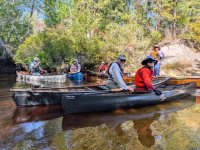
Marc laughs as Robert learns that a D15 is too long to turn across this stretch of this river.
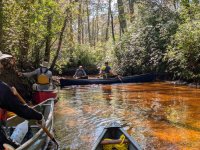
If your canoe has a virgin bottom, it won't after 30 minutes in some Pine Barrens rivers. You will slide, scrape and skooch over scores of logs, stumps and beaver dams—and emerge with many hard-earned and fond-memory battle scratches.
Perhaps the ultimate Pinelands over-a-log maneuver is the Reg Blomfield "seesaw". Marc begins to do it here . . .
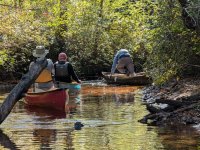
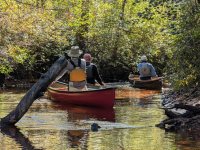
. . . but I have it better photo-documented when Curt did it later over another log.
You need the seesaw move when a log blocks the entire width of the river and you can't walk around on the river bank due, for example, to steepness or greenbrier sticker bushes. A seesaw is a skooch over a highly elevated log. You first lift your bow way up by getting yourself back into the stern. Next, power the elevated bow over the log. Then, somehow get way up in the bow to lift the stern, and skooch until you are off the log.
Mark watches as Curt (a 77-year-old, by the way) maneuvers himself into a sitting position in the stern of his Mohawk Solo 13.
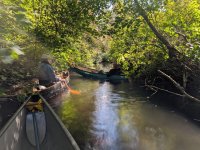
Curt gets the bow elevated and powers on top of the log for the seesaw.
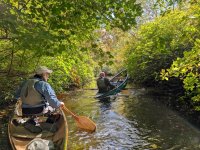
He walks into the bow, gets the stern elevated, and skooches.
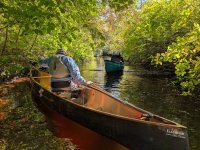
Annnnnd . . . MAKES IT!
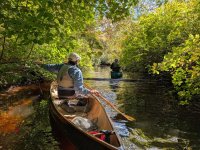
Marc (only 73) does the same thing with ease, and I'm next. I can't crawl into the stern of my narrow Kee 15 to do a seesaw and am afraid to do a regular lean-back ram for fear of breaking my carbon-over-foam hull. I hesitate, procrastinate . . . don't want to try. Jim, behind me, says with cold but clarifying logic, "What else can you do? We have to get past it."
He's right. Suck it up, Glenn.
So I back up, lean back as far as I can, and power onto the log.
Maybe 12 inches.
But it's enough for me to power-skooch over the log, which thankfully is smooth, with about 20 thrusts. After about six seesawing paddlers, the log breaks in half and the rest paddle through, not knowing what the big 30-minute hold-up was.
Later on, the river widens into a beautiful water prairie.
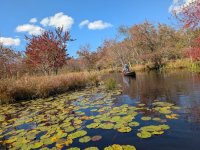
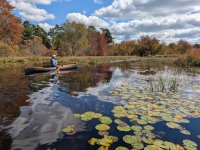
And we stop on a bank there for Thursday lunch.
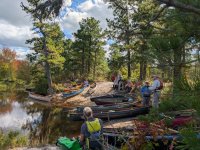
After this lunch, I switch boats with Marc for the rest of the run. He has no trouble railing and spinning my Kee 15. Of course, he finds it too big and too unmaneuverable for his taste. For me, I find the Kee 15 to be a smooth and comfortable lake and tripping canoe, which successfully ran all the twists, turns and obstructions on the trip that the shorter and more maneuverable canoes did, albeit perhaps not as crisply and with some occasional muscling.
Meanwhile, I was literally shocked at how easily Marc's Savage River Illusion turns without having much rocker, while also being easy to track arrow straight with single sided correction strokes and switch paddling. The hull seems to read my mind. Extremely impressed by the Illusion, I do not hesitate to declare it the best Pine Barrens solo canoe I've ever paddled—yes, better than my Wildfire. Similarly, two small women on the trip said that they strongly prefer the Savage River June Bug (also designed by Marc) over their Flashfires.
One day, while others were practicing upstream work on a river, I paddled the lake on which we were camped with Tom in a Northstar Firebird and Nancy in a Swift Prospector 13. These are two other very light and maneuverable canoes.
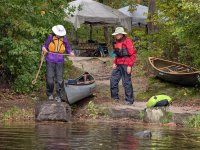
Thursday afternoon, Tim, Bruce and others took down the canopies and began to break camp.
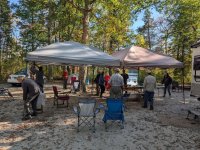
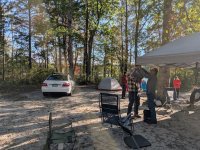
That night it went down to 32°, which was quite cold for us tenters. On Friday, the paddlers who were instructors and students at the Functional Freestyle Workshop drove 10 miles to the beautiful YMCA OF THE PINES in Medford Lakes, New Jersey, and I stopped over for an hour to take a look at the facility and to say my goodbyes.
It was a terrific base camping trip in a very unique paddling milieu, notwithstanding the low water levels. I enjoyed meeting, paddling, eating, and campfire-ing with everyone. I'd like to particularly thank Tim Burris, Bruce Kemp and Marc Ornstein for inviting me . . . and for their friendship.
Bruce and Tim set up canopies at our main gathering site as Marc sits on the hitch of his trailer chatting with Manon.

My corner of that site, which had direct lake access. Most of the trees are oaks, which continuously rained down acorns—banging and cracking on top our our vehicles and canoes, and booming when they hit the top of Marc's trailer. ALL NIGHT.


Marc in his self-designed Savage River Illusion, Curt in a Northstar Firebird and Bruce in a Curtis Dragonfly, prepare to negotiate the first of hundreds of 90° to 170° turns in the Barrens around bank corners and uncountable woody obstacles.

At the lunch spot on Monday, 12 open canoes are lined up on a rare sand beach shore. My gray Swift Keewaydin 15 (in the middle of the pack) and Robert Patch's blue Swift Dragonfly 15 (on the far end) were the longest canoes on the trip, and mine was the least maneuverable. Robert and I swapped canoes for an hour or so this day.

Back in his Swift D15, Robert and others in front of him enter a drought-stricken "lake".

A harvest moon shines through the oak trees at night in camp . . .

. . . and lightens up the sky and lake waters at the campsite.

Every morning, most of us had breakfast at the Red Barn, which is located on a three-generation family farm and makes all their own pastries.


To run the many twisty, serpentine, convoluted, torturous and labyrinthine streams of the Pinelands, you are best prepared if you are in a maneuverable canoe and are skilled with strokes in all four quadrants of the canoe. For the acute and nonstop turns, and the frequent downed-tree, log and brush and sticker-bush obstructions, you will succeed best if you are skilled in currents with axles, posts, wedges, cross-axles, cross-posts, drawing and prying sideslips, draws, cross-draws, and cross-forward strokes. You will also need the simple back, far back and compound back strokes because you sometimes need to back up intentionally so as to make a move or get out of a checkmate. Also useful are impromptu paddle pushes off the bank or a log and hand-grabs of a branch.
Here, Marc does a cross-forward sweep as he ducks under multiple branches of a downed tree. There are scores of such obstructions on some of the rivers.

Sometimes, you must duck so low that no part of your body extends above the gunwales. In order to be able to do that from a central solo seat, the bow thwart must be at least 40 inches from the front edge of the seat, as Marc specifies for the Savage River solo canoes he has designed (June Bug, Illusion, Harmony).
The importance of this was empirically verified for me when I watched Marc disappear under his Illusion gunwales to get under a tree that spanned the river about 24 inches above the water. My boat went under the tree but my body-bend was blocked by my bow thwart, and hence my life-jacketed back caught on the trunk. There I was, wedged under the tree in current in a bent-over position. Checkmate!
Fortunately, the current was not strong in the low-water conditions, and Marc was able to push me backwards out from under the trunk. I then had to execute a turning compound back stroke get all the way out from under the log and angle my canoe for a forward stroke explosion to a narrow opening near the bank, which I should have taken in the first place. Good judgment, boat control and experience are all necessary when deciding whether, how and where to run complex obstructions.
For example, many of the logs and trees require angled "Z" maneuvers. Hence, unless you have a very short and turnable canoe, you might have to run the first part of a Z obstruction forward and the second part backward—or vice versa. Here, Robert is running his long canoe backward between the first and second trunks until he can duck under the second, which will enable him to run the next obstruction forward. Meanwhile the current is pushing him into the trunk and trying to tip him over, so he uses his hands as well as paddling to "make the move".

Buuuuut . . . there is another log lurking right after the first three. Sometimes you only have 10 seconds or so before you have to execute another complex maneuver around yet another obstruction or corner or both.
All is not so convoluted. Here, Manon paddles down a straight, canopied tunnel of coloring leaves . . .

. . . only needing to employ a slight head tilt on her next stroke.

However, a few minutes later Manon approaches a serious problem. The old railroad trestle has vertical pilings just inches under the water that block and grab all hulls.

The right channel of the trestle is completely blocked by branches and brush. The center channel has too many sharp underwater pilings. So, we all must try our best on the least-blocked channel, which is the left. But Manon gets hung on the underwater grab-monsters (as we all do), and first tries to pull herself with her left hand while pushing one-handed with her paddle.

That doesn't work. So, she resorts to the method you must use many times on some of the rivers, which is to "skooch" the canoe by sliding/rocking it forward while up on your knees, hands on the gunwales.

That eventually worked for her, as it did for me, and we watch the entire group of paddlers take about 15-20 minutes to "skooch the trestle". Curt is now in a Mohawk Solo 13, which has the reputation of being perhaps the best Royalex freestyle canoe.

On yet another day, he paddled a Curtis Dragonfly. Note all the tannin in this river.

Some of the group sits on logs at a lunch spot.

While the canoes also get a well-needed rest.

Bruce Kemp and Manon's husband, Jim Satrape, prefer to stand. Bruce organizes the Western Pennsylvania Solo Canoe Rendezvous (WPASCR).

Manon and Jim at another day's lunch spot. They organize the Midwest Canoe Symposium.

After lunch, Paul and Jesse look upstream at something.

Marc laughs as Robert learns that a D15 is too long to turn across this stretch of this river.

If your canoe has a virgin bottom, it won't after 30 minutes in some Pine Barrens rivers. You will slide, scrape and skooch over scores of logs, stumps and beaver dams—and emerge with many hard-earned and fond-memory battle scratches.
Perhaps the ultimate Pinelands over-a-log maneuver is the Reg Blomfield "seesaw". Marc begins to do it here . . .


. . . but I have it better photo-documented when Curt did it later over another log.
You need the seesaw move when a log blocks the entire width of the river and you can't walk around on the river bank due, for example, to steepness or greenbrier sticker bushes. A seesaw is a skooch over a highly elevated log. You first lift your bow way up by getting yourself back into the stern. Next, power the elevated bow over the log. Then, somehow get way up in the bow to lift the stern, and skooch until you are off the log.
Mark watches as Curt (a 77-year-old, by the way) maneuvers himself into a sitting position in the stern of his Mohawk Solo 13.

Curt gets the bow elevated and powers on top of the log for the seesaw.

He walks into the bow, gets the stern elevated, and skooches.

Annnnnd . . . MAKES IT!

Marc (only 73) does the same thing with ease, and I'm next. I can't crawl into the stern of my narrow Kee 15 to do a seesaw and am afraid to do a regular lean-back ram for fear of breaking my carbon-over-foam hull. I hesitate, procrastinate . . . don't want to try. Jim, behind me, says with cold but clarifying logic, "What else can you do? We have to get past it."
He's right. Suck it up, Glenn.
So I back up, lean back as far as I can, and power onto the log.
Maybe 12 inches.
But it's enough for me to power-skooch over the log, which thankfully is smooth, with about 20 thrusts. After about six seesawing paddlers, the log breaks in half and the rest paddle through, not knowing what the big 30-minute hold-up was.
Later on, the river widens into a beautiful water prairie.


And we stop on a bank there for Thursday lunch.

After this lunch, I switch boats with Marc for the rest of the run. He has no trouble railing and spinning my Kee 15. Of course, he finds it too big and too unmaneuverable for his taste. For me, I find the Kee 15 to be a smooth and comfortable lake and tripping canoe, which successfully ran all the twists, turns and obstructions on the trip that the shorter and more maneuverable canoes did, albeit perhaps not as crisply and with some occasional muscling.
Meanwhile, I was literally shocked at how easily Marc's Savage River Illusion turns without having much rocker, while also being easy to track arrow straight with single sided correction strokes and switch paddling. The hull seems to read my mind. Extremely impressed by the Illusion, I do not hesitate to declare it the best Pine Barrens solo canoe I've ever paddled—yes, better than my Wildfire. Similarly, two small women on the trip said that they strongly prefer the Savage River June Bug (also designed by Marc) over their Flashfires.
One day, while others were practicing upstream work on a river, I paddled the lake on which we were camped with Tom in a Northstar Firebird and Nancy in a Swift Prospector 13. These are two other very light and maneuverable canoes.

Thursday afternoon, Tim, Bruce and others took down the canopies and began to break camp.


That night it went down to 32°, which was quite cold for us tenters. On Friday, the paddlers who were instructors and students at the Functional Freestyle Workshop drove 10 miles to the beautiful YMCA OF THE PINES in Medford Lakes, New Jersey, and I stopped over for an hour to take a look at the facility and to say my goodbyes.
It was a terrific base camping trip in a very unique paddling milieu, notwithstanding the low water levels. I enjoyed meeting, paddling, eating, and campfire-ing with everyone. I'd like to particularly thank Tim Burris, Bruce Kemp and Marc Ornstein for inviting me . . . and for their friendship.

